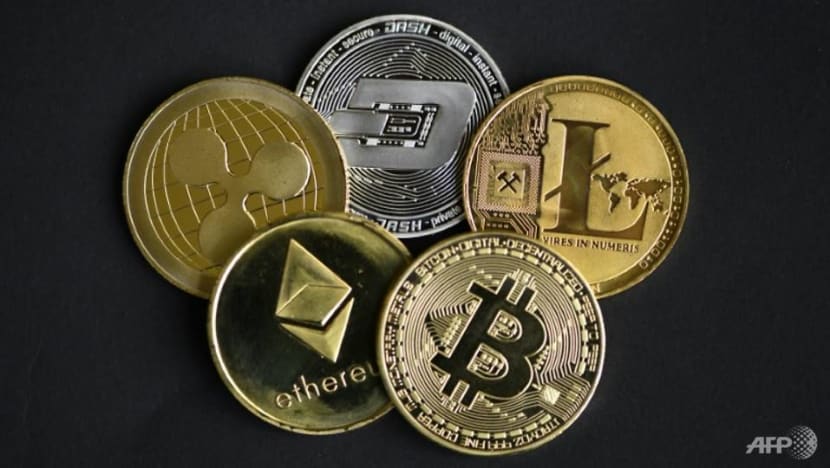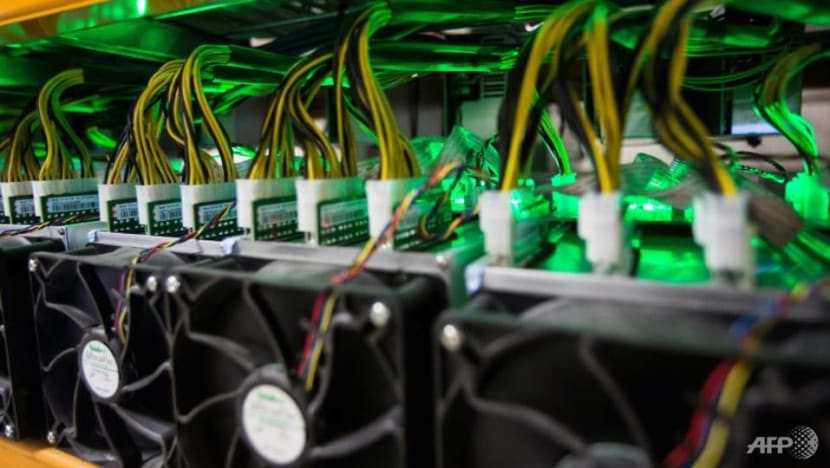Commentary: Cryptocurrencies have huge appeal despite holes
Under the intense glare and scrutiny of regulators everywhere, what lies ahead for cryptocurrency? Is it still the currency of the future or is it simply a castle built on sand? Nanyang Business School’s Cindy Deng Xin gives her take.

A representation of different cryptocurrencies. (File photo: AFP/Ina Fassbender)
SINGAPORE: If you’ve ever used or thought of using cryptocurrency to make a payment for goods or services, you are part of a fashionable group that accounts for about 37 per cent of Singapore’s population according to a survey by WorldPay from FIS Generation Pay Research.
You're likely intrigued by the numerous cash rebate programmes offered by service providers of such digital payment tokens to pay with crypto on gift cards for iTunes, Grab, Shopee, Cold Storage, or various F&B places.
And though COVID-19 has impacted tourism, maybe you’re one of the few who’s still travelling and find it handy to make foreign payments without incurring overseas transaction costs imposed by banks.
Or perhaps it's fun to pay with cryptocurrency. After all, who wouldn’t want to be associated with a cutting-edge technology that might be on par with cash and gold some day?
Most of us are still much more accustomed to using e-payment or credit cards, which have already offered a whole new level of convenience. Crypto payments are unlikely to offer much of a difference here.
Even then, there are very few stores that accept cryptocurrency directly. Rather, in most situations, buyers must first purchase a cash card or gift card to make a payment.
In fact, most of us might be discouraged from experimenting with cryptocurrency as payment, when the unpredictable cryptocurrency values over the past year have jangled our nerves.
If you had converted your Singapore dollars to Bitcoin in November 2021, you’ll understand. From more than S$90,000 a piece, these bitcoins have seen their value nearly halved by mid-late January when the price fell to roughly S$47,000.
TIGHTENING REGULATIONS ON CRYPTOCURRENCIES
While cryptocurrency payments are becoming more popular in Singapore, the Monetary Authority of Singapore (MAS) has issued guidelines prohibiting DPT (Digital Payment Token) service providers from engaging in marketing activities that target the general public, such as public transport services, broadcast, and print media, or third parties such as social media influencers.
These guidelines follow a year of heightened scrutiny of cryptocurrency businesses by global regulators, with new legal frameworks hurriedly knocked out.
According to data from blockchain think tank Huobi Research Institute, more than 40 countries and regions approved more than 150 regulatory measures and advice for the cryptocurrency business in 2021, representing a 75 per cent increase over the previous year.
Singapore is not an exception in comprehending this new industry and actively forming the regulatory framework, though Singapore has been embracing the innovation of blockchain and cryptocurrency with the vision of becoming a worldwide crypto centre.
Among the fintech innovations, the blockchain and cryptocurrency segment stands for the largest part, accounting for 20 per cent of all fintech companies in Singapore.
Because the prices of cryptocurrencies are vulnerable to large speculative fluctuations, MAS has frequently warned of their high risks and unsuitability for the general public. MAS takes the position of protecting customers from engaging in trading cryptocurrencies on the spur of the moment without fully appreciating the risks involved.

THE FUTURE OF CURRENCY OR A CASTLE BUILT ON SAND?
Strictly speaking, cryptocurrencies, including the most popular two with the largest market capitalisation Bitcoin and Ethereum, are not money because they lack the function of a store of value, which requires the value of money to remain stable over time.
Bitcoin is often seen as "digital gold" to store value or hedge against other investments, whereas Ethereum has been said to be “digital oil.” This is because that many recent advances in the crypto world are effectively smart contracts running on Ethereum. To run smart contracts, you need Ethereum, like the way the world runs on oil.
Then there are stablecoins, like Tether, which peg their market value to the price of a currency or commodity, such as US dollars or gold, and ensure price stability through collateralisation, which necessitates independent custodians and frequent audits to guarantee enough reserve backing.
Tether has become the third-largest cryptocurrency by market capitalisation. However, most people are more accustomed to fiat currency backed by a central bank and may be distrustful about stablecoins issued by a private entity.
While stablecoins are designed to be 100 per cent backed by cash reserves, Tether’s reserves breakdown, however, indicates that 52.51 per cent out of the 84.25 per cent of cash and cash equivalents is commercial paper, which is not a risk-free asset.
That is, if the reserves assets fall in price, stablecoins very likely become non-redeemable. Furthermore, the information of reserves is rarely transparently disclosed or independently audited. That said, stablecoins are still a higher level of trust compared to other cryptocurrencies.
I would argue cryptocurrency is not quite the sandcastle some may think it is.
THE KEY IS IN BLOCKCHAIN TECHNOLOGY
Despite concerns over cryptocurrencies, banks and financial institutions see value in the underlying technology. Central banks are actively experimenting with central bank digital currencies (CBDC) to capitalise on the potential benefits of blockchain technology and distributed ledgers.
Recently, China is pushing its e-CNY, a form of CBDC, to the broader population after piloting through lotteries to distribute red envelopes in a few cities. E-CNY will replace cash and coins in circulation and does not bear interest.
Apart from payment services, banks are implementing blockchain technology in a variety of business segments as well, including real-time cross-border transactions, trade finance, know-your-customer due diligence and fraud prevention.
Consider trade finance: One of the greatest hazards to trade partners is the potential of fraud since the same cargo might be mortgaged many times due to inadequate oversight over the flow of goods and documentation.
One example is ZenRock, a Singapore-based oil dealer who was accused of engaging in dishonest operations in early 2020 by utilising the same oil cargo to get loans from several lenders.
Banks frequently can only write it off as a business cost. DBS, Standard Chartered and HSBC, have been exploring blockchain solutions to improve trade financing. Payments between importers and exporters could be made in tokenised form using blockchain technology, based on the delivery or receipt of products.
Importers and exporters might use smart contracts to set up procedures securing automated payments and avoid the risk of lost, delayed, or repeatedly mortgaged cargoes.
Blockchain, the underlying technology of cryptocurrency, has the potential to increase the efficiency and transparency of the financial system.
And there may come a day when digital currencies become a more widely accepted means of payment such that the ordinary crypto investor might consider buying for groceries with cryptocurrency.

MUCH WORK BEFORE CRYPTOCURRENCIES BECOME MAINSTREAM
So, the question is, what is the tipping point? The tables will turn when there is a cryptocurrency with the potential of having a steady price and widespread adoption.
But the prospects are gloomy for now. Meta had launched the Diem project, to catalyse a dollar-backed stablecoin and payment system. But it was smacked despite trying to follow rules.
Now the Diem Association is reportedly considering selling its assets to repay investors. If the world’s largest social media with a solid use case couldn’t pull this off, the case for cryptocurrencies has still some way to go.
Then again, new technology is inevitably accompanied by hype and pushback. The regulatory pressure before a technology becomes mature are huge.
Even with the best intentions, it is extremely difficult to strike a balance between flexible regulation to capitalise on the potential advantages of new technologies and tougher restrictions to protect regular investors from overexposure to speculative price movements.
Here, in the short run, regulators may need to refine existing regulatory measures – like what MAS has done this time to protect the public. It is worth considering the type of investor we are dealing with too.
While the average crypto investor in the United States is a 38-year-old male with an annual income of around US$111,000 (S$150,000), the average male crypto user in Singapore is around 29 years old with an annual household income of around S$52,000, according to the Gemini 2021 State of Crypto in US and Singapore reports.
How one woman lost money in a cryptocurrency scam:
A more restrictive policy could include limiting crypto trading to accredited individuals with extensive understanding of the investment risks connected with crypto.
More study into what regulations should aim to achieve is needed. A panel of financial authorities reached the conclusion that stablecoins "should be regulated as financial market infrastructure alongside payment systems and clearing houses" last October.
Aside from that, it is critical to ensure stablecoins don’t contain credit risk or the peg to real-world currencies or assets does not break. Regulatory guidelines on independent custody and audit will help.
For now, as to retail CBDC, Singapore is keeping its options open. As MAS Managing Director Ravi Menon said at the Singapore FinTech Festival last November, "the case for a retail CBDC in Singapore is not urgent," but MAS is "embarking on Project Orchid" to "build the technical competencies" if “Singapore decide to issue a digital Singapore dollar in the future."
It is early days yet but there’s still future in cryptocurrency – it just needs time.
Cindy Deng Xin is an Associate Professor (Practice) of Finance at Nanyang Business School, NTU.



















